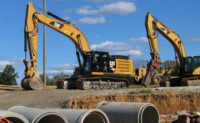"During the recession, prices for concrete were 9% lower," Wingfield says. "The economy is now changing, and we're starting to see asphalt winning more of these contracts." The entire project is ahead of schedule and $80 million under budget. Including soft costs, I-69 is $300 million under budget, INDOT says. Project officials cite flexibility of design and construction as one way INDOT has accelerated the work along I-69.
Another schedule driver has been the high-profile nature of the project. "We did not want to be the contractor that kept it from opening," says Tom Graf, assistant vice president of Kokosing Construction, Columbus. "We had to do two years of work in one year." Kokosing was hired to build a twin-span, 4,400-ft-bridge over the Patoka River, an environmentally sensitive floodplain.
Engineering the soil under the road has been another challenge. The project runs through coal country, wetlands, wildlife preserves and karst landscapes. These geologically diverse features include sinkholes and caves, some of which are home to federally endangered species, such as the Indiana bat.
With Indiana's karst, "there are a bunch of challenges," says Walter Kutschke, geotechnical manager in Pittsburgh for URS Corp., which designed Section 4. He notes two main considerations: protecting motorists from sinkholes and preventing stormwater runoff from damaging the geology.
URS, which performed extensive dye traces prior to construction, designed a combination of reverse-aggregate filters and sinkhole seals to control the flow of water from the new highway. "If you can't control the water, you are going to end up with a mess," Kutschke says.
Loose soil conditions have required other extreme engineering. Contractors employed dynamic compaction on areas near coal mines. Workers stabilized the soil by dropping a 15-ton weight about 30 ft to the ground, which was built up using about 250,000 cu yd of embankment material.
In another part of the route, whose contract will be awarded this spring, the road crosses over Black Ankle Creek, which lies in a 4,400-ft-wide valley founded on unstable soil. Rather than build a continuous bridge, designers chose to build two giant embankments, running 1,100 and 1,400 ft long and standing 120 and 60 ft high, respectively. They will bookend a 1,900-ft-long bridge.
Building the embankments will require adding 5% lime and consolidating the soil using 3 million lineal ft of wick drains, similar to those used on recent levees built in New Orleans. Contractors will construct the fill in 25-ft to 40-ft lifts separated by a high-strength geotextile fabric. Measuring 4 million cu yd, the mounds will be topped with 4-ft clay caps.
"We saved something like $15 million to $20 million by using this approach," says John Volk, geotechnical manager for URS in Fort Washington, Pa. With the remaining sections of I-69 not yet funded, further ingenuity may be required to complete the ambitious route.



Post a comment to this article
Report Abusive Comment